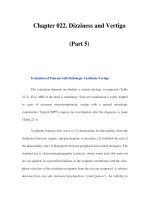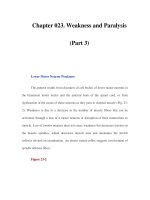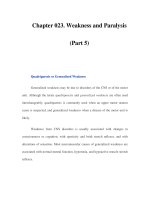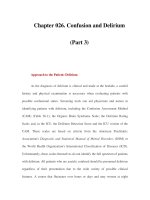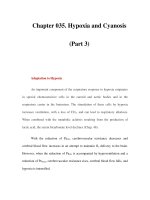Chapter 053. Eczema and Dermatitis (Part 13) ppt
Bạn đang xem bản rút gọn của tài liệu. Xem và tải ngay bản đầy đủ của tài liệu tại đây (33.52 KB, 5 trang )
Chapter 053. Eczema and
Dermatitis
(Part 13)
Acne Vulgaris
Acne vulgaris is a self-limited disorder primarily of teenagers and young
adults, although perhaps 10–20% of adults may continue to experience some form
of the disorder. The permissive factor for the expression of the disease in
adolescence is the increase in sebum production by sebaceous glands after
puberty. Small cysts, called comedones , form in hair follicles due to blockage of
the follicular orifice by retention of keratinous material and sebum. The activity of
bacteria (Proprionobacterium acnes) within the comedones releases free fatty
acids from sebum, causes inflammation within the cyst, and results in rupture of
the cyst wall. An inflammatory foreign-body reaction develops as result of
extrusion of oily and keratinous debris from the cyst.
The clinical hallmark of acne vulgaris is the comedone, which may be
closed (whitehead) or open (blackhead). Closed comedones appear as 1- to 2-mm
pebbly white papules, which are accentuated when the skin is stretched. They are
the precursors of inflammatory lesions of acne vulgaris. The contents of closed
comedones are not easily expressed. Open comedones, which rarely result in
inflammatory acne lesions, have a large dilated follicular orifice and are filled with
easily expressible oxidized, darkened, oily debris. Comedones are usually
accompanied by inflammatory lesions: papules, pustules, or nodules.
The earliest lesions seen in adolescence are generally mildly inflamed or
noninflammatory comedones on the forehead. Subsequently, more typical
inflammatory lesions develop on the cheeks, nose, and chin (Fig. 53-7). The most
common location for acne is the face, but involvement of the chest and back is
common. Most disease remains mild and does not lead to scarring. A small
number of patients develop large inflammatory cysts and nodules, which may
drain and result in significant scarring. Regardless of the severity, acne may affect
a patient's quality of life. If adequately treated, this may be a transient effect. In the
case of severe, scarring acne, the effects can be permanent and profound. Early
therapeutic intervention in severe acne is essential.
Figure 53-7
Acne vulgaris. An example of acne vulgaris with inflammatory papules,
pustules, and comedones. (Courtesy of Kalman Watsky, MD; with permission.)
Exogenous and endogenous factors can alter the expression of acne
vulgaris. Friction and trauma (from headbands or chin straps of athletic helmets),
application of comedogenic topical agents (cosmetics or hair preparations), or
chronic topical exposure to certain industrial compounds may elicit or aggravate
acne. Glucocorticoids, topical or systemic, may also elicit acne. Other systemic
medications such as oral contraceptive pills, lithium, isoniazid, androgenic
steroids, halogens, phenytoin, and phenobarbital may produce acneiform eruptions
or aggravate preexisting acne. Genetic factors and polycystic ovary disease may
also play a role.
Acne Vulgaris: Treatment
Treatment of acne vulgaris is directed toward elimination of comedones by
normalization of follicular keratinization, decreasing sebaceous gland activity,
decreasing the population of P. acnes, and decreasing inflammation. Minimal to
moderate, pauci-inflammatory disease may respond adequately to local therapy
alone. Although areas affected with acne should be kept clean, overly vigorous
scrubbing may aggravate acne due to mechanical rupture of comedones. Topical
agents such as retinoic acid, benzoyl peroxide, or salicylic acid may alter the
pattern of epidermal desquamation, preventing the formation of comedones and
aiding in the resolution of preexisting cysts. Topical antibacterial agents such as
azelaic acid, topical erythromycin (with or without zinc), or clindamycin are also
useful adjuncts to therapy.
Patients with moderate to severe acne with a prominent inflammatory
component will benefit from the addition of systemic therapy, such as tetracycline
in doses of 250–500 mg bid, or doxycycline, 100 mg bid. Minocycline may also
be useful. Such antibiotics appear to have an anti-inflammatory effect independent
of their antibacterial effect. Female patients who do not respond to oral antibiotics
may benefit from hormonal therapy. Women placed on oral contraceptives
containing ethinyl estradiol and norgestimate have demonstrated improvement in
their acne when compared to a placebo control.
Patients with severe nodulocystic acne unresponsive to the therapies
discussed above may benefit from treatment with the synthetic retinoid,
isotretinoin. Its dose is based on the patient's weight, and it is given once daily for
5 months. Results are excellent in appropriately selected patients. Its use is highly
regulated due to its potential for severe adverse events, primarily teratogenicity.
Additionally, patients receiving this medication develop extremely dry skin,
cheilitis, and must be followed for development of hypertriglyceridemia. Recently
there have also been concerns that it is associated with severe depression in some
patients. The latter has not been proved. At present, prescribers must enroll in a
program designed to prevent pregnancy and adverse events while patients are
taking isotretinoin. These measures are imposed to ensure that all prescribers are
familiar with the risks of isotretinoin; that all female patients have two negative
pregnancy tests prior to initiating therapy and a negative pregnancy test prior to
each refill; and that all patients have been warned about the risks associated with
isotretinoin.
